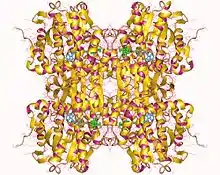Adénosylhomocystéinase
L'adénosylhomocystéinase est une hydrolase qui catalyse la réaction :
Adénosylhomocystéinase

| N° EC | EC |
|---|---|
| N° CAS | |
| Cofacteur(s) | NAD+ |
| IUBMB | Entrée IUBMB |
|---|---|
| IntEnz | Vue IntEnz |
| BRENDA | Entrée BRENDA |
| KEGG | Entrée KEGG |
| MetaCyc | Voie métabolique |
| PRIAM | Profil |
| PDB | RCSB PDB PDBe PDBj PDBsum |
| GO | AmiGO / EGO |
Elle intervient dans le métabolisme de l'adénosine, une base nucléique, et de la cystéine, un acide α-aminé protéinogène.
Notes et références
- (en) Xiaoda Yang, Yongbo Hu, Daniel H. Yin, Mary A. Turner, Mengmeng Wang, Ronald T. Borchardt, P. Lynne Howell, Krzysztof Kuczera et Richard L. Schowen, « Catalytic Strategy of S-Adenosyl-l-homocysteine Hydrolase: Transition-State Stabilization and the Avoidance of Abortive Reactions », Biochemistry, vol. 42, no 7, , p. 1900-1909 (PMID 12590576, DOI 10.1021/bi0262350, lire en ligne)
- (en) G. de la Haba et G. L. Cantoni, « The enzymatic synthesis of S-adenosyl-L-homocysteine from adenosine and homocysteine », Journal of Biological Chemistry, vol. 234, no 3, , p. 603-608 (PMID 13641268, lire en ligne)
- (en) J. L. Palmer et R. H. Abeles, « The mechanism of action of S-adenosylhomocysteinase », Journal of Biological Chemistry, vol. 254, no 4, , p. 1217-1226 (PMID 762125, lire en ligne)
Cet article est issu de wikipedia. Text licence: CC BY-SA 4.0, Des conditions supplémentaires peuvent s’appliquer aux fichiers multimédias.
